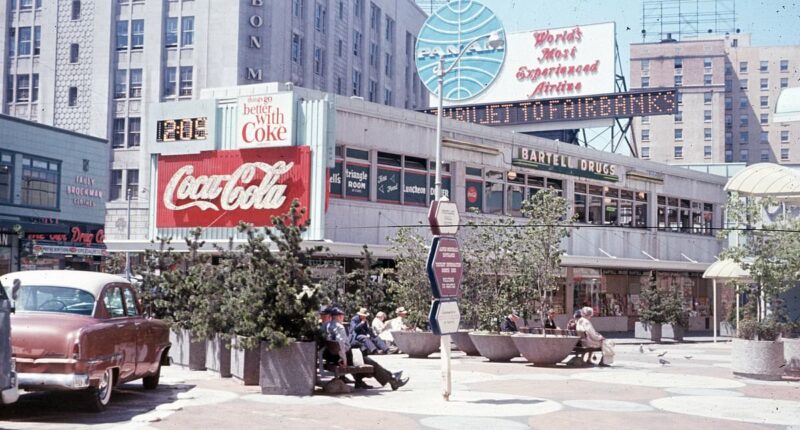Share this @internewscast.com
The great American drugstore shakeout has claimed another victim — as yet another regional favorite vanishes from the high street.
After 135 years in operation, one of Washington’s most renowned pharmacy chains has permanently closed its doors, shutting down its last three branches over the weekend following weeks of major sales events.
This closure is part of a broader trend affecting the industry, with major players like Rite Aid declaring bankruptcy and both Walgreens and CVS closing multiple outlets due to changing customer behaviors and increased economic challenges.
The most recent to succumb is Bartell Drugs, a Seattle-headquartered chain admired for its strong local character and commitment to the community. Established in 1890, Rite Aid took control of it in 2020, at which point it had 67 operational stores.
However, ongoing difficulties at both firms led to a gradual rebranding or closure of stores, culminating in the final shutdowns in Kirkland, Mill Creek, and Gig Harbor.
Molly Lavinter, 48, described the closings as the ‘end of an era’, to the Seattle Times.
Standing outside the Gig Harbor Bartell, beneath windows adorned with bright sale signs, Lavinter expressed, ‘I grew up with Bartell’s… It’s like a piece of my childhood disappearing.’
Within the Puget Sound area, Bartell Drugs was famed for its dedication to local engagement, excellent customer service, and community support. It was recognized for having a distinct local presence, often featuring products from local suppliers and endorsing local activities.

Bartell Drugs, a regional pharmacy based in Seattle, shut down its final stores last weekend
The store’s headquarters was in Seattle, WA, where it was established in 1890 by George H Bartell Sr.
Bartell Drugs was considered the oldest family-owned drugstore chain in the US.
The chain’s financial woes came slowly and then all at once.
In July – two months after Rite Aid filed its second bankruptcy – CVS said it would take 20 of the remaining 34 Bartell stores.
CVS spent the summer rebranding the chosen locations.
The 14 stores left over saw their pharmacies shuttered and prescriptions sent to nearby CVS locations.
Signs outside started coming down and liquidation teams arrived to sell the remaining inventory.
The iconic candy, wine, and gifts that once lined the drug store’s shelves had disappeared as bargain hunters moved down the aisles in search of final deals.

Bartell Drugs was considered the oldest family-owned drugstore chain in the US (the shop is pictured in 1937)
The iconic Washington chain closed its last locations after 135 years of operation (Bartell Drugs is pictured in 1965)
‘We tried to stay local and quirky,’ recalled John Lewis, 56, Bartell’s former regional manager and food and beverage buyer, who stopped by the Mill Creek store Friday to visit a former co-worker.
For Bartell’s employees and shoppers, the closures were hardly surprising. After Rite Aid acquired the chain years ago, it became clear that things were going downhill.
Rite Aid hoped the acquisition would help its own financial struggles – and the larger drug store brand promised to maintain Bartell’s unique business model.
However, the pandemic turned Rite Aid’s problems into a full-blown disaster and both brands got to a point of no return.
Rite Aid quickly became one of the nation’s most popular pharmaceutical chains after opening its first store in Pennsylvania in 1962.
At its peak in 2008, the chain was operating over 5,000 locations, making it the third-largest pharmacy in the US.
The chain had been struggling for quite some time before it was forced to file for bankruptcy in 2023.
By that time, the chain was operating 2,100 stores, and planning to close hundreds after receiving $3.45billion in new financing to create a restructuring plan.

George H Bartell Sr established the company in 1890

Bartell Drugs had a strong local identity and often carried products from local vendors and supported local events

Several pharmacy chains have announced massive lists of store closures across the US (Pictured: signage at a Rite Aid store in Michigan)
The plan was initially successful after slashing $2billion in debt and securing $2.5billion in exit financing.
However, its restructuring efforts slowly crumbled, and by April of this year, Rite Aid was plotting its second bankruptcy.
Rite Aid has not been the only major pharmacy to struggle. Even CVS has been forced to shut locations across the country.
Earlier this year, the drug store, which had over 9,000 locations across the US, confirmed that 270 stores would shutter this year.
The closures, which the company initially announced in October last year, have been underway in several states, with Alabama, New York, Maryland, and Missouri seeing the largest number of closures.




